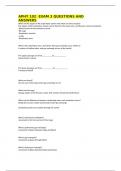-
1. Tentamen (uitwerkingen) - Aphy 102 - exam 3 nutrition and metabolism questions and answers
-
2. Tentamen (uitwerkingen) - Aphy 102 - exam 3 nutrition and metabolism questions and answers
-
3. Tentamen (uitwerkingen) - Aphy 102 - exam 3 nutrition and metabolism questions and answers
-
4. Tentamen (uitwerkingen) - Aphy 102 - exam 3 nutrition and metabolism questions and answers
-
5. Tentamen (uitwerkingen) - Aphy 102 - ivy tech - f-m reproductive system (test) questions and answers
-
6. Tentamen (uitwerkingen) - Aphy 102 anatomy and physiology study questionscomplete with a+ graded answers
-
7. Tentamen (uitwerkingen) - Aphy 102 blood exam with correct answers 100%
-
8. Tentamen (uitwerkingen) - Aphy 102 exam 1 chapters 13 – 15 questions and answers
-
9. Tentamen (uitwerkingen) - Aphy 102 exam 1 endocrine system and blood questions and answers
-
10. Tentamen (uitwerkingen) - Aphy 102 exam 3 chapter (19-21)review questions and answers 2024
-
11. Tentamen (uitwerkingen) - Aphy 102 exam 3 chapter (19-21) questions and answers 2024
-
12. Tentamen (uitwerkingen) - Aphy 102 exam 3 practice questions and answers
-
13. Tentamen (uitwerkingen) - Aphy 102 exam 3 questions and answers
-
14. Tentamen (uitwerkingen) - Aphy 102 exam 3 questions and answers
-
15. Tentamen (uitwerkingen) - Aphy 102 exam 3 practice questions and answers
-
16. Tentamen (uitwerkingen) - Aphy 102 exam 3 questions and answers
-
17. Tentamen (uitwerkingen) - Aphy 102 exam 3 questions and answers
-
18. Tentamen (uitwerkingen) - Aphy 102 lecturer exam 3 questions and answers
-
19. Tentamen (uitwerkingen) - Aphy 102 exam 4 with correct answers graded a+
-
20. Tentamen (uitwerkingen) - Aphy 102 exam 4 questions and answers a+ graded
-
21. Tentamen (uitwerkingen) - Aphy 102 exam 4 questions and answers a+ graded
-
22. Tentamen (uitwerkingen) - Aphy 102 exam 4 questions and answers
-
23. Tentamen (uitwerkingen) - Aphy 102 lecture exam
-
24. Tentamen (uitwerkingen) - Aphy 102 final exam questions and answers 2024
-
25. Tentamen (uitwerkingen) - Aphy 102 final exam quiz study guide
-
26. Tentamen (uitwerkingen) - Aphy 102 final exam quiz study guide
-
27. Tentamen (uitwerkingen) - Aphy102 final exam sg
-
28. Tentamen (uitwerkingen) - Aphy 102 final exam with correct answers
-
29. Tentamen (uitwerkingen) - Aphy 102 final exam with correct answers
-
30. Tentamen (uitwerkingen) - Aphy 102 final exam with correct answers
-
31. Tentamen (uitwerkingen) - Aphy 102 final exam review with correct answers
-
32. Tentamen (uitwerkingen) - Aphy 102 final exam with correct answers
-
33. Tentamen (uitwerkingen) - Aphy 102 final exam questions and answers 2024
-
34. Tentamen (uitwerkingen) - Aphy 102 final ivy tech exam with correct answers 20242025
-
35. Tentamen (uitwerkingen) - Aphy 102 final- ivy tech summer exam questions and answers
-
36. Tentamen (uitwerkingen) - Aphy 102 final lab cumulative, exam 1 review material- questions and answers
-
37. Tentamen (uitwerkingen) - Aphy 102 ivy tech final study guide 2024
-
38. Tentamen (uitwerkingen) - Aphy 102 ivy tech midterm exam questions and answers
-
39. Tentamen (uitwerkingen) - Aphy 102 ch 17: endocrine system ivy tech
-
40. Tentamen (uitwerkingen) - Aphy 102 ivy tech, lecture, exam 1 endocrine system and blood - questions and answers...
-
41. Tentamen (uitwerkingen) - Aphy 201 lab exam 2
-
42. Tentamen (uitwerkingen) - Aphy 102 lab exam 2 with correct answers 100%
-
43. Tentamen (uitwerkingen) - Aphy 102 midterm exam - ivy tech questions and answers
-
44. Tentamen (uitwerkingen) - Aphy 102 midterm-ivytech exam questions and answers
-
45. Tentamen (uitwerkingen) - Aphy 102 quiz 1 with complete solutions
-
46. Tentamen (uitwerkingen) - Aphys test 3 review|complete questions with a+ graded answers
-
47. Tentamen (uitwerkingen) - Aphy 102 test 3 questions and answers 2024 graded a+
-
Meer zien




